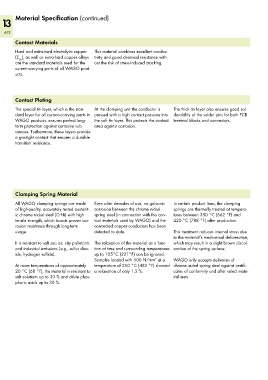Page 614 - Wago_PCB_TerminalBlocksConnectors_Volume2_2015_US
P. 614
13 Material Specification (continued)
612
Contact Materials
Hard and extra-hard electrolytic copper This material combines excellent conduc-
(E ), as well as extra-hard copper alloys tivity and good chemical resistance with-
Cu
are the standard materials used for the out the risk of stress-induced cracking.
current-carrying parts of all WAGO prod-
ucts.
Contact Plating
The special tin layer, which is the stan- At the clamping unit the conductor is The thick tin layer also ensures good sol-
dard layer for all current-carrying parts in pressed with a high contact pressure into derability of the solder pins for both PCB
WAGO products, ensures perfect long- the soft tin layer. This protects the contact terminal blocks and connectors.
term protection against corrosive sub- area against corrosion.
stances. Furthermore, these layers provide
a gas-tight contact that ensures a durable
transition resistance.
Clamping Spring Material
All WAGO clamping springs are made Even after decades of use, no galvanic In certain product lines, the clamping
of high-quality, accurately tested austenit- corrosion between the chrome nickel springs are thermally treated at tempera-
ic chrome nickel steel (CrNi) with high spring steel (in connection with the con- tures between 350 °C (662 °F) and
tensile strength, which boasts proven cor- tact materials used by WAGO) and the 420 °C (788 °F) after production.
rosion resistance through long-term connected copper conductors has been
usage. detected to date. This treatment reduces internal stress due
to the material‘s mechanical deformation,
It is resistant to salt sea air, city pollutants The relaxation of the material as a func- which may result in a slight brown discol-
and industrial emissions (e.g., sulfur diox- tion of time and surrounding temperatures oration of the spring surface.
ide, hydrogen sulfide). up to 105°C (221°F) can be ignored.
Samples loaded with 500 N/mm at a WAGO only accepts deliveries of
2
At room temperatures of approximately temperature of 250 °C (482 °F) showed chrome nickel spring steel against certifi-
20 °C (68 °F), the material is resistant to a relaxation of only 1.5 %. cates of conformity and after select mate-
salt solutions up to 30 % and dilute phos- rial tests.
phoric acids up to 30 %.

